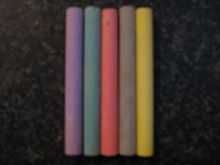Sidewalk chalk


Sidewalk chalk are typically large colored (and sometimes white or cream) sticks of chalk (calcium sulfate rather than rock chalk, calcium carbonate) mostly used for drawing on pavement or cement sidewalk. It is sometimes used by children to draw a four square court or a hopscotch board. Blackboard chalk is typically shorter and white.
There are several different types of sidewalk chalk, typically coming in solid-colored sticks. 3-D sidewalk chalk sets, in which each stick of chalk is created with two particular colors that appear 3-dimensional when viewed through the 3-D glasses that come with the chalk, also exist.[1]
Sidewalk chalk can be cheaply homemade.[2]
Use
Sidewalk chalk is used at some universities to advertise for events, especially where there is much concrete. Prohibitions are set for where students can chalk, usually limiting it to areas that will be washed away with rain, or areas which are set to be cleaned of chalk markings.
Some teachers promote use of sidewalk chalk on a carpet as an interactive teaching tool.[3]
Although sidewalk chalk is created to allow people to draw on sidewalks or pavement, some law enforcement agencies may prohibit sidewalk drawing in certain areas without first being requested for authorization.[4]
Events
On September 16–17 in the year 2006, a global event was held to promote peace through sidewalk chalk drawings.[5] Chalk4Peace was a project planned by an artist from Arlington, Virginia named John Aaron, who asked children and teens from the age of eight to age eighteen to participate in groups across the world to draw chalk drawings that would illustrate peace for one of the Chalk4Peace events.[5] Designated areas on sidewalks, pavement, and cement were used for the participants to draw on while volunteers took pictures of the street paintings.[5] Aaron used his own money and donations to provide sidewalk chalk to areas of the world that he believed did not have access to good quality chalk.[5]
There are many competitions for chalk artists, including the Pavement Art Competition in the Bold Street Festival in Liverpool in 2010.
Art
Artists such as Kurt Wenner, Ellis Gallagher and Julian Beever have created intricate and realistic street paintings using the chalk and pastels. It is typical for sidewalk chalk artists to use anamorphic drawing when drawing with sidewalk chalk. Nonanamorphic drawing are drawings that are drawn to be observed face-on, whereas anamorphic drawings are drawn to be observed from a different viewpoint. Julian Beever, in a Q&A with Adam Boretz,[4] explained his drawing of his first anamorphic sidewalk chalk drawing, Swimming Pool:
- I was drawing conventional pavement pictures—portraits of the famous, copies of old masters [before anamorphic pavement drawing].
- There was one particular street in Brussels that had large rectangles of tiles set in the pavement…I used these rectangles as frames
- for my drawings…I had done this many times when one day I suddenly realized I could use these tiles as if they were the outside
- surround of a mini-swimming pool. All I had to do was color them and then fill in the pool inside…I was so impressed with the result…
- that I had to do more.[4]
References
- ↑ 3-D sidewalk chalk. (2008). Scholastic Parent & Child, 16(2), 14.
- ↑ Make your own sidewalk chalk. (1998, July 21). Christian Science Monitor. 13.
- ↑ Davenport, J. (2007). Classroom essentials. Teacher Magazine, 18(4), 16.
- ↑ 4.0 4.1 4.2 Boretz, A., & Beever, J. (2010). Where the sidewalk ends. Publishers Weekly, 257(41), 34.
- ↑ 5.0 5.1 5.2 5.3 Prest, M. J. (2006). Drawn together. Chronicle Of Philanthropy, 18(23), 1.
External links
- Busker Alley - videos of sidewalk artists with chalks and paints
- Gallery of sidewalk chalk art drawn by children
- Drawing on Earth World's Largest Chalk Drawing